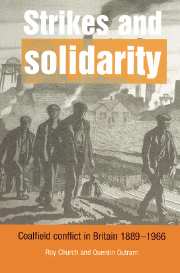Book contents
- Frontmatter
- Contents
- List of figures and tables
- Preface
- List of abbreviations
- 1 Interpreting coalfield conflict: focus and formulations
- 2 Tradition and modernity: the mining industry 1889–1940
- 3 Employers and workers: organizations and strategies
- 4 Employers and workers: ideologies, attitudes and political orientations
- 5 Configurations of strike activity
- 6 Strike participation and solidarity before 1912
- 7 Strikes, organization and consciousness in 1912 and after
- 8 Conflictual context? The ‘isolated mass’ revisited
- 9 Mining and modernity: size, sectionalism and solidarity
- 10 The foundations of strike propensity
- 11 Miners and management: agency and action
- 12 Industrial relations and strikes after nationalization
- 13 International perspectives
- 14 Myths and realities: strikes, solidarity and ‘militant miners’
- General appendix
- List of references
- Index
6 - Strike participation and solidarity before 1912
Published online by Cambridge University Press: 04 December 2009
- Frontmatter
- Contents
- List of figures and tables
- Preface
- List of abbreviations
- 1 Interpreting coalfield conflict: focus and formulations
- 2 Tradition and modernity: the mining industry 1889–1940
- 3 Employers and workers: organizations and strategies
- 4 Employers and workers: ideologies, attitudes and political orientations
- 5 Configurations of strike activity
- 6 Strike participation and solidarity before 1912
- 7 Strikes, organization and consciousness in 1912 and after
- 8 Conflictual context? The ‘isolated mass’ revisited
- 9 Mining and modernity: size, sectionalism and solidarity
- 10 The foundations of strike propensity
- 11 Miners and management: agency and action
- 12 Industrial relations and strikes after nationalization
- 13 International perspectives
- 14 Myths and realities: strikes, solidarity and ‘militant miners’
- General appendix
- List of references
- Index
Summary
One enduring assertion in the literature concerned with coalfield conflict is the association of coalmining strikes with solidarity:
A strike with small beginnings in a section of a face in a pit usually spreads quickly to involve the whole pit and evokes responses from the various sections of the neighbourhood. Adjoining pits tend to respond to each other's difficulties. Miners assume that there should be solidarity over whatever area relates to their dispute. They, therefore, expect sympathetic action from other Areas [of the National Union of Mineworkers] and other unions. When it does not occur they ask why and set out to get it. (Allen 1981: 182)
Yet the notion that British miners' strike behaviour has always been solidaristic is a myth.
We saw in the last chapter that strikes rarely extended beyond the confines of a single locality and a single colliery (tables 5.1 and 5.2). ‘Sympathetic strikes’ were rare: of the 4,000 strikes recorded in the 1921–40 period, only 60 (1.5 per cent) were classed as ‘sympathetic’ by the Ministry of Labour. The day-to-day experience of the industry was of small-scale strike action taken by people who all worked in the same pit or lived in the same community or were employed by the same company. But even within the pit the scope of solidary behaviour appears to have been much more restricted than myth would allow. This chapter documents this assertion as a prelude to a re-examination of miners' solidarity at national and local level during the period up to the first national strike in 1912.
- Type
- Chapter
- Information
- Strikes and SolidarityCoalfield Conflict in Britain, 1889–1966, pp. 95 - 112Publisher: Cambridge University PressPrint publication year: 1998



